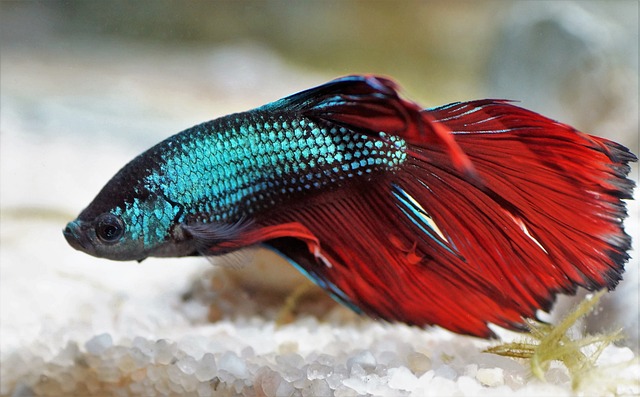Can Siamese Algae Eaters and Betta Fish Live Together?
Many aquarium enthusiasts enjoy keeping a variety of fish species together in their tanks. One common question that arises is whether Siamese Algae Eaters (SAEs) and Betta fish can coexist peacefully. In this article, we will explore the compatibility of these two species and provide some guidance on creating a harmonious aquarium environment.
Siamese Algae Eaters, also known as SAEs or Crossocheilus Siamensis, are popular fish among aquarists due to their ability to control algae growth in the tank. They are peaceful and non-aggressive, making them an attractive choice for community tanks. These fish are native to Southeast Asia and are known for their slender bodies and distinctive black stripes running horizontally along their length.
On the other hand, Betta fish, or Betta splendens, are renowned for their vibrant colors and elaborate fins. These fish are native to the rice paddies and shallow waters of Southeast Asia and are known for their territorial nature. Male Betta fish, in particular, are notorious for their aggression towards other males, which is why they are often kept alone in their own tanks.
Given the stark differences in behavior and habitat preferences between Siamese Algae Eaters and Betta fish, it is generally not recommended to house them together in the same tank. Betta fish are known to be highly territorial and may perceive the presence of SAEs as a threat, leading to aggression and potential harm to both species.
However, there are instances where Siamese Algae Eaters and Betta fish can coexist peacefully. It is crucial to consider the specific temperament of the Betta fish and the size of the tank when attempting to keep these two species together. If the Betta fish has a relatively docile nature and the tank is spacious enough to provide separate territories, it may be possible to house them together.
When introducing SAEs and Betta fish into the same tank, it is essential to closely monitor their behavior and be prepared to separate them if any signs of aggression occur. Providing ample hiding spots and visual barriers, such as plants or decorations, can help create separate territories and reduce stress for both species.
Furthermore, it is crucial to ensure that the tank is large enough to accommodate the swimming and territorial needs of both species. A tank size of at least 20 gallons is recommended to provide enough space for the Betta fish to establish its territory and for the SAEs to roam and forage for algae.
In conclusion, while Siamese Algae Eaters and Betta fish may not be the most compatible tank mates, it is possible for them to coexist peacefully under the right conditions. Careful observation, proper tank size, and the consideration of individual temperaments are key factors in creating a harmonious environment for both species.
Understanding Siamese Algae Eaters
Siamese Algae Eaters, also known as SAEs or Crossocheilus siamensis, are popular freshwater fish often chosen for their ability to control algae growth in aquariums. They are native to Southeast Asia and are well-regarded for their algae-eating habits.
SAEs have a slender, elongated body with a black horizontal stripe running along their sides. They can grow up to 6 inches in length and are generally peaceful and non-aggressive towards other fish species.
One of the reasons why Siamese Algae Eaters are highly sought after by aquarium enthusiasts is their efficiency in managing algae growth. These fish have a voracious appetite for various types of algae, including green spot algae, black beard algae, and hair algae. They can quickly clean up an aquarium infested with these unwanted plants, helping to maintain a healthy and aesthetically pleasing environment for other aquatic life.
Another interesting characteristic of SAEs is their ability to adapt to different water conditions. They can thrive in a wide range of water parameters, including pH levels between 6.5 and 7.5 and temperatures between 75°F and 80°F. This adaptability makes them suitable for both beginner and experienced aquarists, as they can be easily integrated into existing setups without the need for extensive adjustments.
Despite their algae-eating prowess, Siamese Algae Eaters also require a balanced diet to ensure their overall health and well-being. While they primarily feed on algae, it is important to supplement their diet with other foods to provide them with the necessary nutrients. High-quality sinking pellets, frozen or live foods such as brine shrimp or bloodworms, and even blanched vegetables like spinach or zucchini can be offered to SAEs to ensure they receive a well-rounded diet.
When it comes to tankmates, Siamese Algae Eaters are generally peaceful and can coexist with a variety of other fish species. However, it is important to choose tankmates that are not overly aggressive or territorial, as SAEs may become stressed in such environments. Additionally, it is advisable to keep them in groups of three or more to prevent any potential aggression or territorial behavior among themselves.
In conclusion, Siamese Algae Eaters are highly beneficial and fascinating fish to have in an aquarium. Their ability to control algae growth, adaptability to different water conditions, and peaceful nature make them an ideal choice for both novice and experienced fishkeepers. By providing them with a balanced diet and suitable tankmates, aquarists can enjoy the beauty of a well-maintained aquarium while also benefiting from the natural algae control provided by these remarkable fish.
Despite their aggressive nature, Betta fish are still a popular choice for many aquarium enthusiasts due to their unique characteristics and stunning appearance. These fish are native to the rice paddies, canals, and floodplains of Southeast Asia, particularly Thailand, Cambodia, and Vietnam. In their natural habitat, Betta fish live in shallow, stagnant waters where they have adapted to survive in oxygen-deprived conditions.
One of the most striking features of Betta fish is their vibrant colors and flowing fins. Their scales can come in a wide range of hues, including vibrant reds, blues, purples, and even metallic shades. The long, flowing fins of male Betta fish, known as their “caudal fins,” are particularly impressive and have earned them the nickname “Siamese fighting fish.”
Despite their beauty, it’s important to understand the unique needs and behaviors of Betta fish before adding them to your aquarium. Due to their territorial nature, it’s generally recommended to keep Betta fish in individual tanks or in a tank with only peaceful tank mates. Mixing them with other aggressive or fin-nipping fish can lead to stress, injury, and even death.
Betta fish are labyrinth fish, which means they have a specialized organ called a labyrinth organ that allows them to breathe air from the surface. This adaptation enables them to survive in low-oxygen environments and is one of the reasons why they can thrive in small, unfiltered tanks. However, it’s still important to provide them with a well-maintained and appropriately sized tank that allows for proper swimming space and filtration.
When it comes to feeding, Betta fish are carnivorous and primarily eat insects, small crustaceans, and zooplankton in the wild. In captivity, they can be fed a diet of high-quality Betta pellets or flakes, as well as occasional treats like frozen or live foods. It’s important not to overfeed them, as Betta fish are prone to obesity and related health issues.
Overall, Betta fish can make fascinating and visually stunning additions to aquariums, as long as their unique needs are met. With proper care, a Betta fish can live for several years and bring joy and beauty to any aquatic environment.
6. Water Parameters
Maintaining suitable water parameters is crucial for the health and well-being of both Siamese Algae Eaters and Betta fish. While SAEs are adaptable to a wide range of water conditions, Betta fish prefer slightly acidic to neutral water with a temperature range of 75-82°F (24-28°C). It is important to regularly test and monitor the water parameters to ensure they are within the appropriate range for both species.
7. Introduction and Acclimation
When introducing Siamese Algae Eaters and Betta fish to the same tank, it is important to follow a proper acclimation process. This involves gradually introducing the new fish to the tank environment to minimize stress and reduce the chances of aggression. It is recommended to keep the new fish in a separate quarantine tank for a few weeks to observe their behavior and ensure they are healthy before introducing them to the main tank.
8. Gender Considerations
The gender of the Betta fish can also play a role in their compatibility with Siamese Algae Eaters. Male Betta fish are generally more aggressive and territorial compared to females. Keeping a female Betta fish with Siamese Algae Eaters may have a higher chance of success as they tend to be less aggressive. However, it is important to note that individual fish personalities can vary, and careful observation is still necessary.
By considering these factors and implementing the necessary precautions, it is possible to create a harmonious and compatible environment for Siamese Algae Eaters and Betta fish. However, it is important to remember that every fish is unique, and there is always a risk of aggression or incompatibility. It is crucial to monitor the tank regularly and be prepared to make adjustments or separate the fish if necessary for their safety and well-being.

